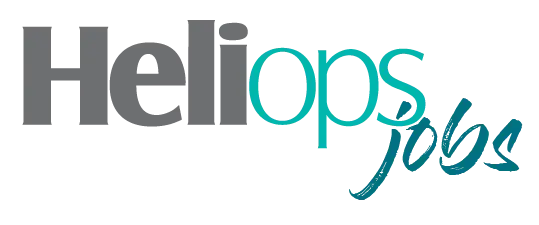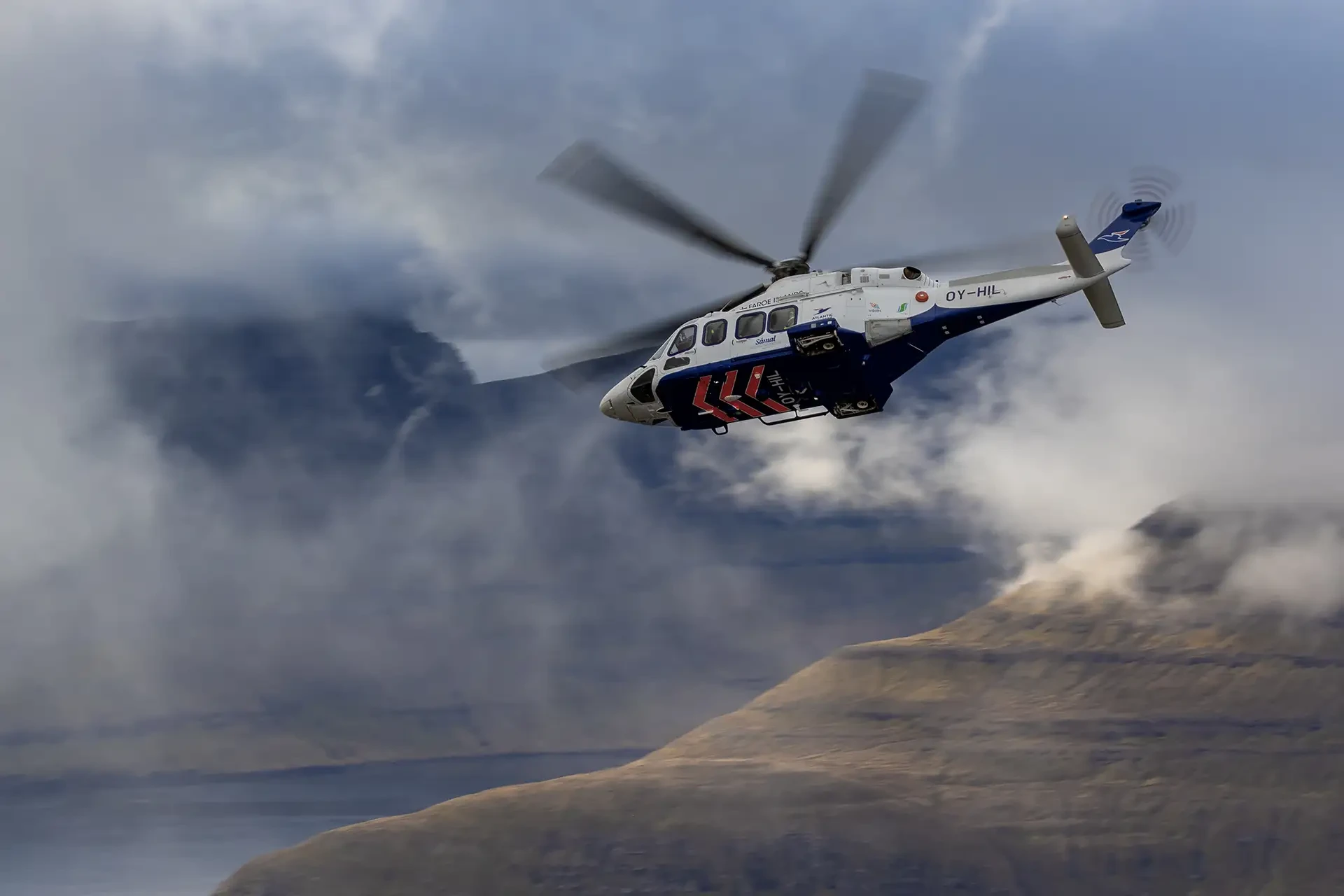Rarely does a helicopter service enjoy absolute national and community support. Atlantic Airways, and its AW139 operation, is one such service providing Search and Rescue, Helicopter Emergency Medical Services and a scheduled service between the islands of the Faroe group, where the only other means is by boat. Mark Ogden had the fortunate job of observing how this service operates.
The Faroe Islands
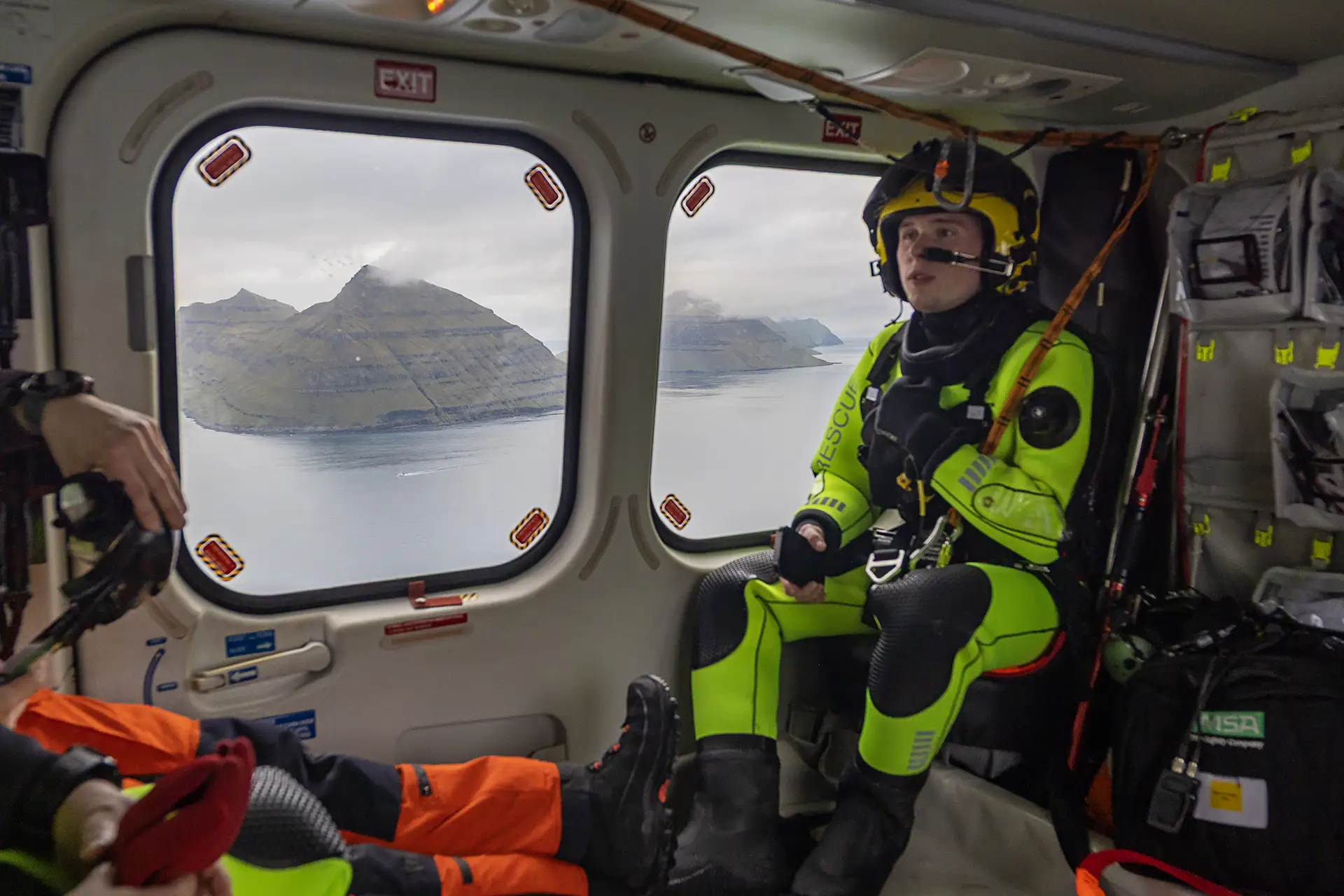
The Faroe Islands, an archipelago of 18 major islands (and numerous smaller islets) located in the North Atlantic Ocean, roughly halfway between Iceland, Norway, and Scotland, form a self-governing administrative division of the Kingdom of Denmark. It has significant autonomy in domestic affairs, while Denmark is responsible for defence and foreign policy. In 2025, the total population was nearly 55,000. Although there are some road tunnels, much of the commuting between the islands is by boat, or the Atlantic Airways Leonardo 139 helicopters.
Weather
The importance of the weather and ocean conditions cannot be overstated when considering why and how the helicopter service developed.
The Faroe islanders are a tough breed; they must be to live and prosper in these North Atlantic islands. The primary maritime current impacting the islands is the North Atlantic Current, an extension of the Gulf Stream. This current brings warm waters from the tropics and tempers the extreme cold typical of the islands' high latitude (around 62°N). Weather patterns are dominated by low-pressure systems of the atmospheric polar front, where cold polar air meets warmer southern air, and then migrate northeast across the Atlantic under the influence of the jet stream, which is a high-altitude easterly wind that sometimes achieve speeds of up to 500 km/h (270kts). These systems can bring persistent rain, strong winds, and significant high and low cloud cover.
As a result, the islands experience a subpolar oceanic climate that is considered mild yet highly variable, with frequent wind, rain, fog,
and overcast conditions. Average winter temperatures are around 3 to 5°C (37 to 41°F) with summer highs of only 9 to 12°C (48 to 54°F).
With roughly 210 rainy days each year, the weather is unpredictable and can change rapidly, sometimes within minutes.
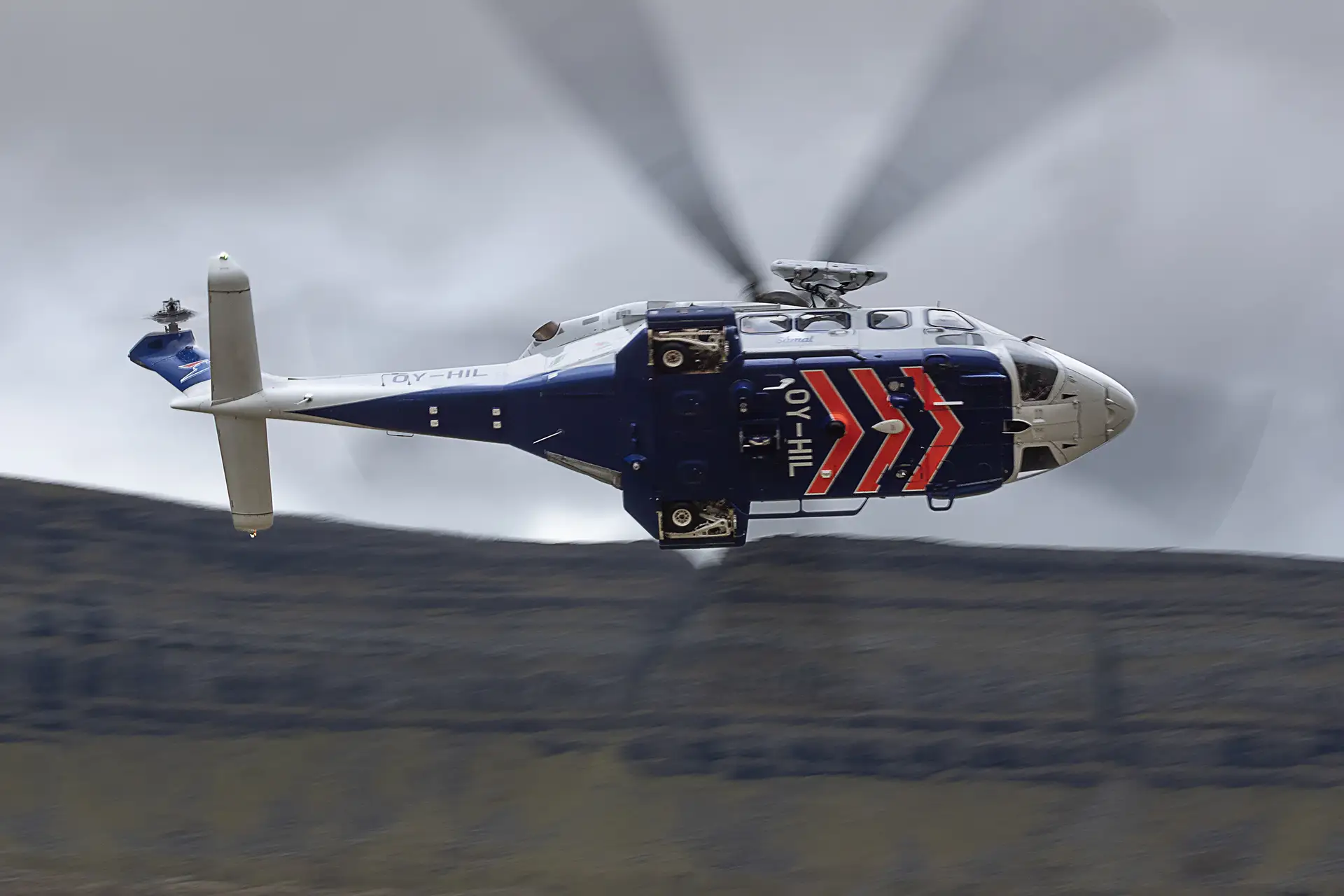
Despite the archipelago’s relatively small size, the islands’ steep mountains (including some of Europe’s steepest sea cliffs) affect the
local weather. Orographic effects from mountains enhance precipitation in certain areas, and fog is common due to the high humidity
interacting with the terrain. Narrow passages between the islands stir tidal currents, which combine with winds to intensify local effects.
As a result, the weather can dramatically differ within short distances, including between adjacent islands. In summary, the weather in and
around the Faroes is extremely and rapidly variable, providing a challenge to the helicopter crews and those who support their operations.
Contending with rain, wind and even mist, the pilots need to be able to read and anticipate the weather and the local effects caused by the terrain. As explained by pilot Rani Herup, the wind, especially in the steep, deep fjords, can generate significant, unpredictable turbulence. The pilots must learn to read what the local weather will be like because the variability and severity can be significant. The weather and its impact on the ocean around the Faroes are probably the biggest challenges for the helicopter crews, and it is often when the weather is bad and maritime operations are affected that the helicopter service’s callout is initiated.
Like the weather, Atlantic storms, tidal flows and the local topography impact the surrounding ocean. It would be fair to say that the
ocean conditions surrounding the islands are, at best, ‘dynamic’. Conditions include major currents, strong tides, and frequent stormy
weather, typically characterised by rough seas, moderate to high waves, and cool water temperatures. The region is part of a key pathway
for Atlantic water inflows, making it ecologically rich but challenging.
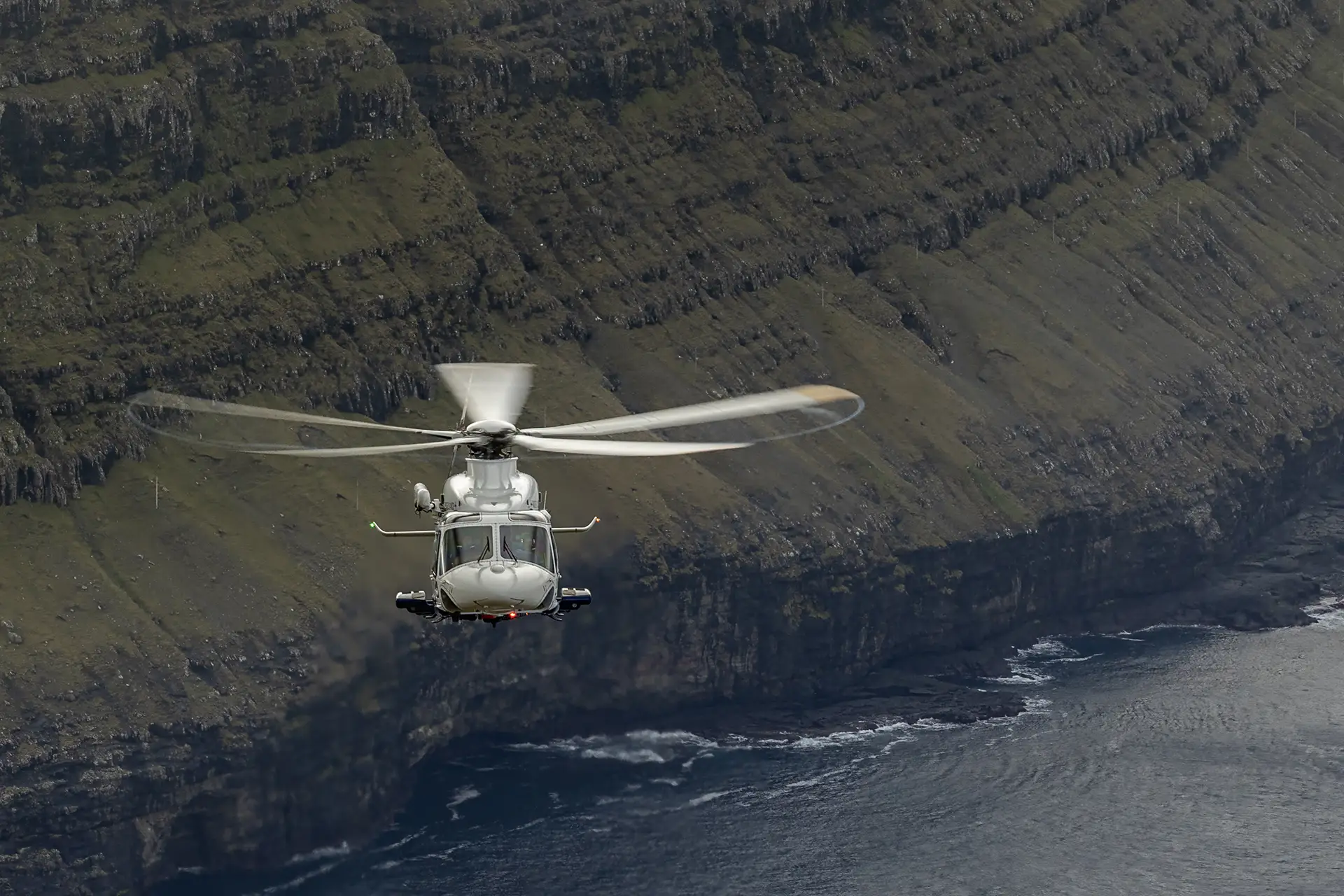
Leonardo 139s
Replacing previously operated helicopters, including the Bell 212 and 412 helicopters, the fleet of two 139s represents a quantum leap in capability; a capability much needed and well utilized in this part of the North Atlantic. “The Bell 212 was primarily used for the passenger, freight and underslung operation from when Atlantic Airways took over the helicopter operation of the Faroe Islands in March 1994,” Captain Jakobsen noted.
“Atlantic Airways was granted a HEMS/SAR contract from the Faroe Government in early January 2001. Sufficient funds were released to purchase one Bell 412 SAR helicopter. In 2008, Atlantic Airways purchased one factory-new AW139 (short nose), which had the primary task of supporting the then oil and gas exploration activity taking place within the Faroe Sea borders.” This helicopter was in addition to the three Bell helicopters.
This AW139 was then later sold to Viking Helicopters in Germany. In late 2015 and early 2016, Atlantic Airways took delivery of two
factory-new AW139s, fully SAR-equipped. These seven-ton helicopters were part of a renewed HEMS/SAR contract with the Faroe Government, with
the Bell helicopters being sold; the Bell 212 going to Air Greenland, and the two 412s to Germany just after the new AW139s arrived in the
Faroes.
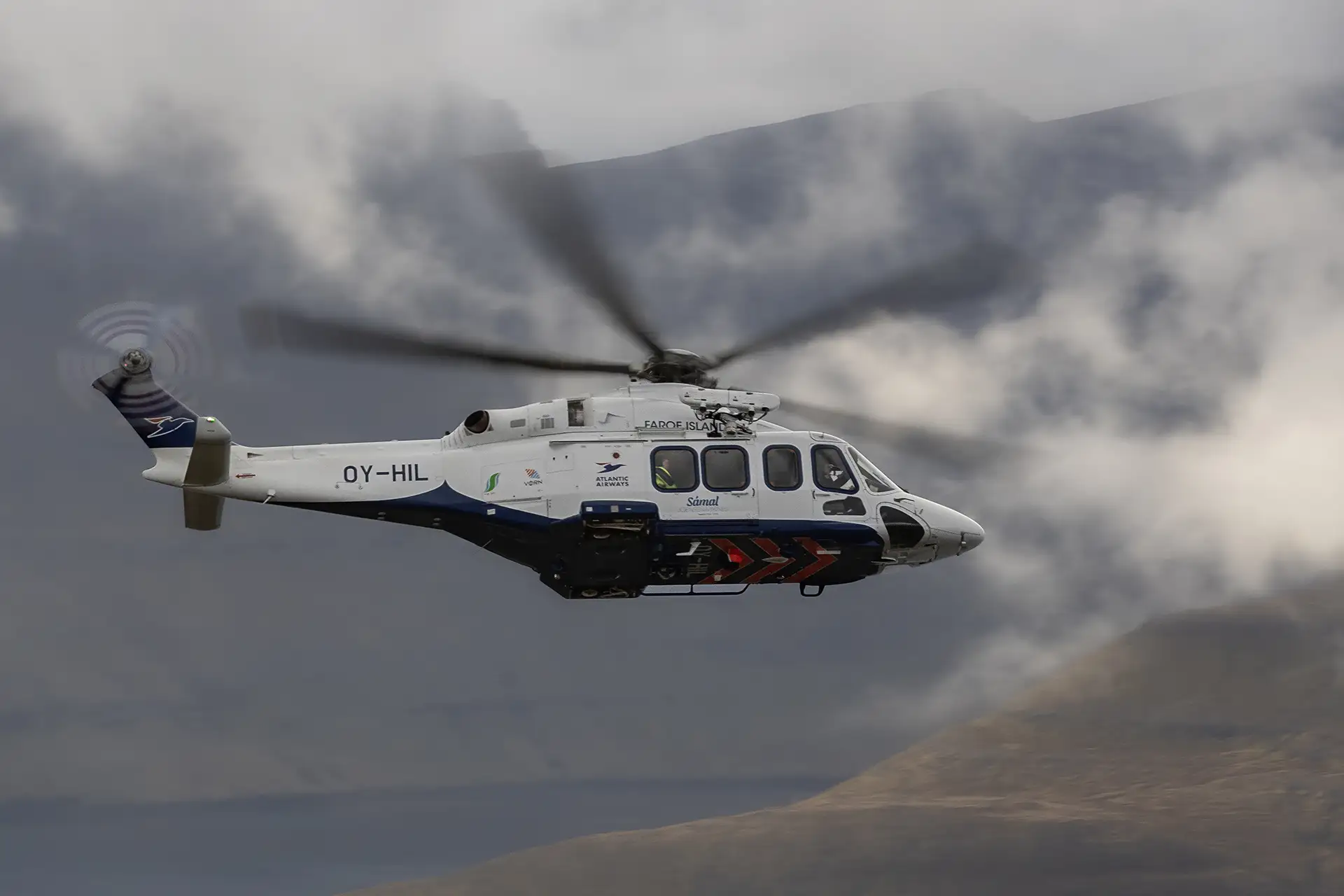
Well-equipped and supported by the Islands’ Government and its operating parent, Atlantic Airways, the current helicopter operation has
grown in capability and importance to the island community. The service operates under Atlantic’s AOC and business support, but operates
pretty well independently otherwise. “We are independent of Atlantic Airways OPS. But otherwise, part of the Atlantic Airways concept and
establishment,” explained Captain Jakobsen.
Being a small organization, its people hold multiple roles and are noticeably dedicated to what they do. Some nine pilots, and seven winch operators/rescue swimmers are employed with the rescue swimmers also having other roles within Atlantic Airways including being licenced engineers, general maintenance and simulator technicians/engineers. Maintenance personnel are dual qualified on the 139 and Atlantic’s fixed-wing aircraft, all working under the Atlantic Airways Part 145 organization. Most of the employees are Faroese.
The Flight Management System (FMS) navigation system uses dual GPS, inertial and Doppler inputs. The Radar Altimeter (RADALT) is a nine-beam system ensuring accurate overwater height keeping. Several instrument routes are preprogrammed to allow the aircraft to clear the islands in all directions accurately. Night Vision Goggles (NVGs) are standard equipment with newer units sourced from Thales. The service has developed a close relationship with Thales through the purchase and development of the full-motion and winch simulators.
With the introduction of the 139, the Faroe Islands later also established an aviation training academy using the latest Thales 139 motion
simulator, a fixed trainer and an innovative and extremely effective winch trainer (that also integrates fully with the full motion
simulator). The academy provides training to other operators at a cost representing about 25 to 30% of the direct operating cost of the
aircraft. The training academy can also provide a ‘package’ that includes transport (through the airline) and accommodation (Hotel Vágar
located next to the facility, also owned and operated by the airline)
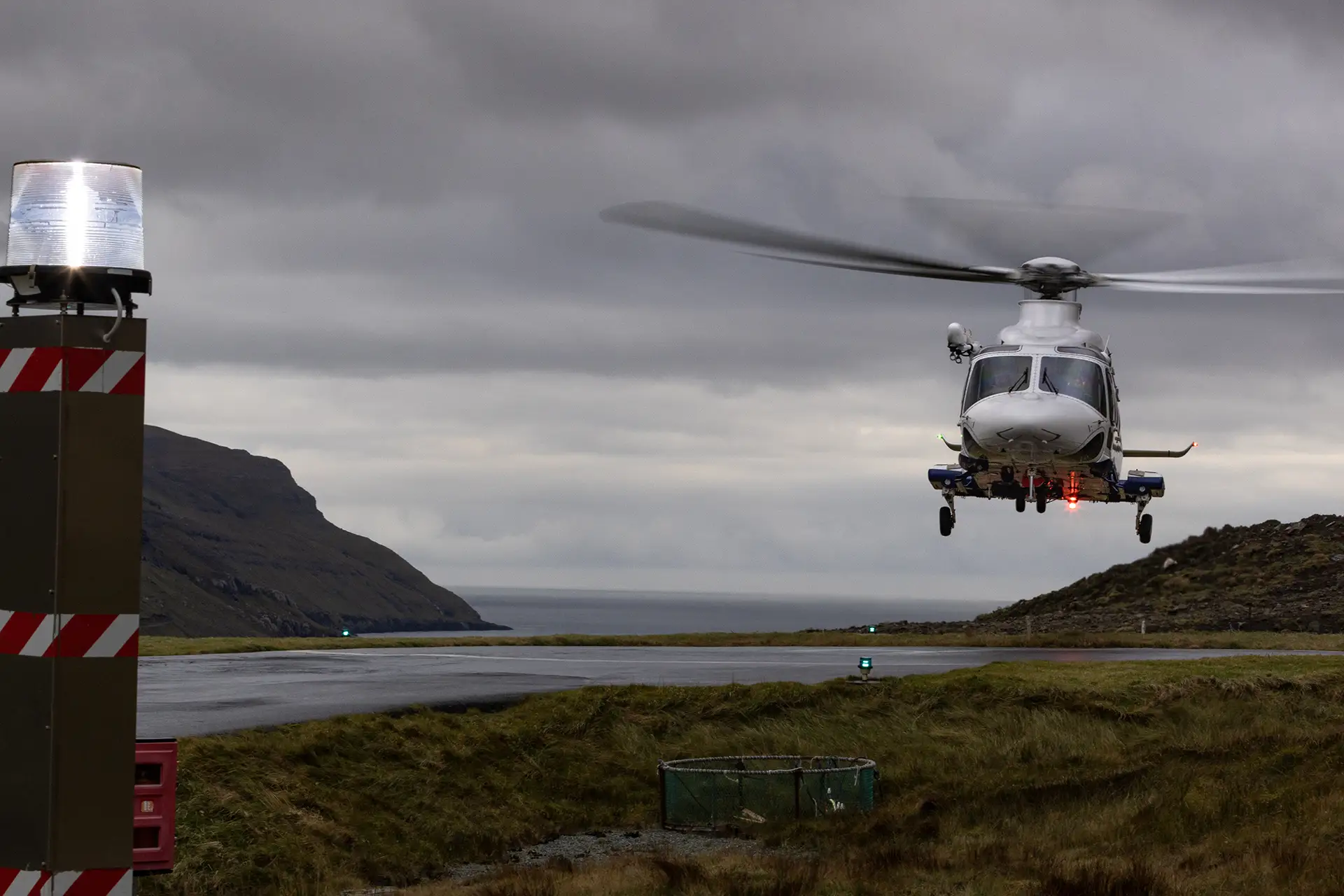
SAR and HEMS
With the larger fuel tanks of the AW139 (long nose) phase 7 aircraft, the aircraft conducts long-range SAR missions; designed to operate out to 200 nautical miles, spend 30 minutes on task, then return. As Hans Erik G. Jakobsen, the helicopter service’s Head of Training, noted, “Probably every islander has a relative or knows someone who has been rescued or helped by this service.” Hans, who gained extensive experience flying in Scandinavia and the Middle East and is a significant driving force of the service, is justifiably proud of what they have achieved and the service’s importance to the Faroe Islands. While the service sings the praises of the AW139 and its capabilities, the maintenance engineers noted that spare parts support was a challenge, especially for a small but vital-to-the-country operator. The helicopters are so important to the community that when both were down for maintenance for two days in over ten years of operations, the event made front-page news.
Captain Jakobsen explained that about 200 flying hours per year were used for HEMS/SAR and HEMS/SAR/HOIST/NVIS training. Soon, much of the hoist training will move to the winch simulator installed alongside the full motion simulator purchased from Thales. The capability and cost-savings represented by the winch simulator (some 75% saving compared to the aircraft’s hourly cost) is significant. As Captain Jakobsen noted, “This is in itself amazing and will save us a lot of aircraft training and thereby a lot of money in the future. The hoist simulator is less than one year old, but the potential is immense.”
“Until now we have always trained new rescuers solely in the aircraft, but in future the inexperienced will be substantially trained in the simulator, and likewise the experienced crew, since the winch part is so realistic.”
The helicopter’s Flight Management System provides a fully coupled departure from Vágar Airport (originally built by British Army Royal Engineers during World War II). The FMS can then fly via pre-determined waypoints through the islands to the North Atlantic; its color display radar ground mapping the islands and painting the often-challenging weather. Five of the 18 islands have at least one helipad and the others have areas identified where the helicopter can land. To assist with landing in poor visibility, the helipads are equipped with surface lights and a high-intensity strobe light flashing the Morse code ‘H’ to help the crews visually identify the helipad’s location in poor conditions. Two of the pads have self-bunded fuel storage tanks.
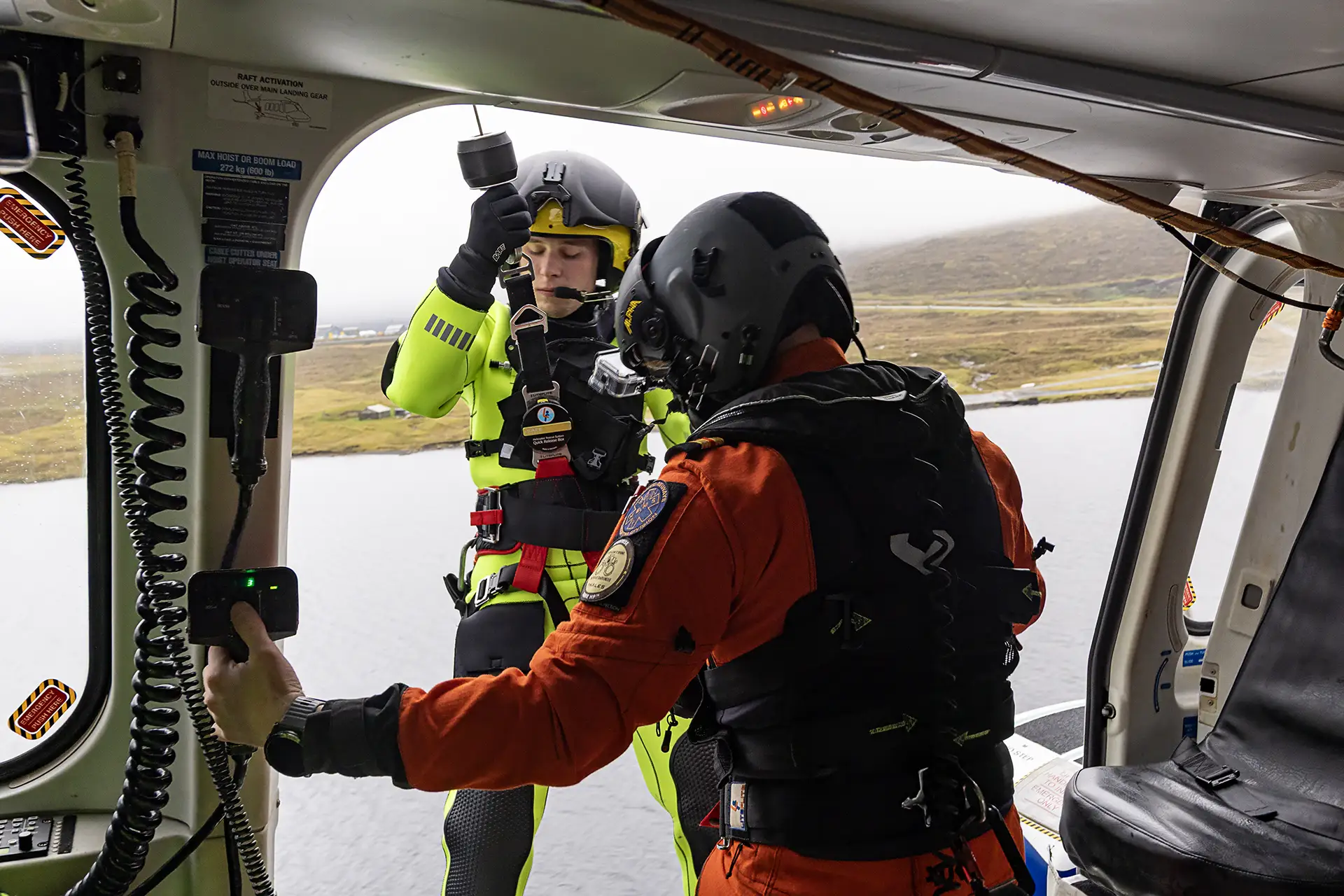
The crews also use third-generation Night Vision Goggles to help with night operations and searches. Atlantics’ standard procedures require
all crew members to use the NVGs. “Every crewmember has his own helmet, own googles, with both flying and non-flying pilots and crew wear
the googles during a mission,” explained Captain Jakobsen. “except for the rescuer during parts of the mission where they are on hoist or
rescuing from the sea or other bodies of water.”
The support the islanders provide the service is more than financial or even moral. When the helicopter crews need a vessel to practice winching, it is usually just a matter of calling on the radio and vessel captains readily offer time. This cooperation, as well as keeping the helicopter crews current, also help keep the vessels’ crews familiar with the procedures.
The rescue crews, including the winch operator and the swimmers, are all employees, mostly young and who also have other company roles, such as maintenance. The service ensures they are well-trained and well-equipped.
When asked about the most difficult rescue performed by the service, Captain Jakobsen replied, “That’s hard to say as we do many difficult rescues.”
“People tend to talk about the big rescues, the most famous being when we rescued 14 sailors about two years ago; the next after this one was when we took 10 sailors from a burning ship, but there are many, and it is impossible to say which is the most difficult one or demanding one.”
“It depends on so many things, like weather, how many people, the experience level of the crew, and so on.”
In training, the helicopter has a ‘wet deck’ installed to minimize the impact of saltwater inside. Corrosion control is a challenge given
that the helicopter spends much of its time over the salt-laden atmosphere of the North Atlantic. The engines are compressor-washed each
day in an effort to minimize salt corrosion of the turbines. The corrosion control is performed to the "severe" condition as
defined in Leonardo’s manuals.
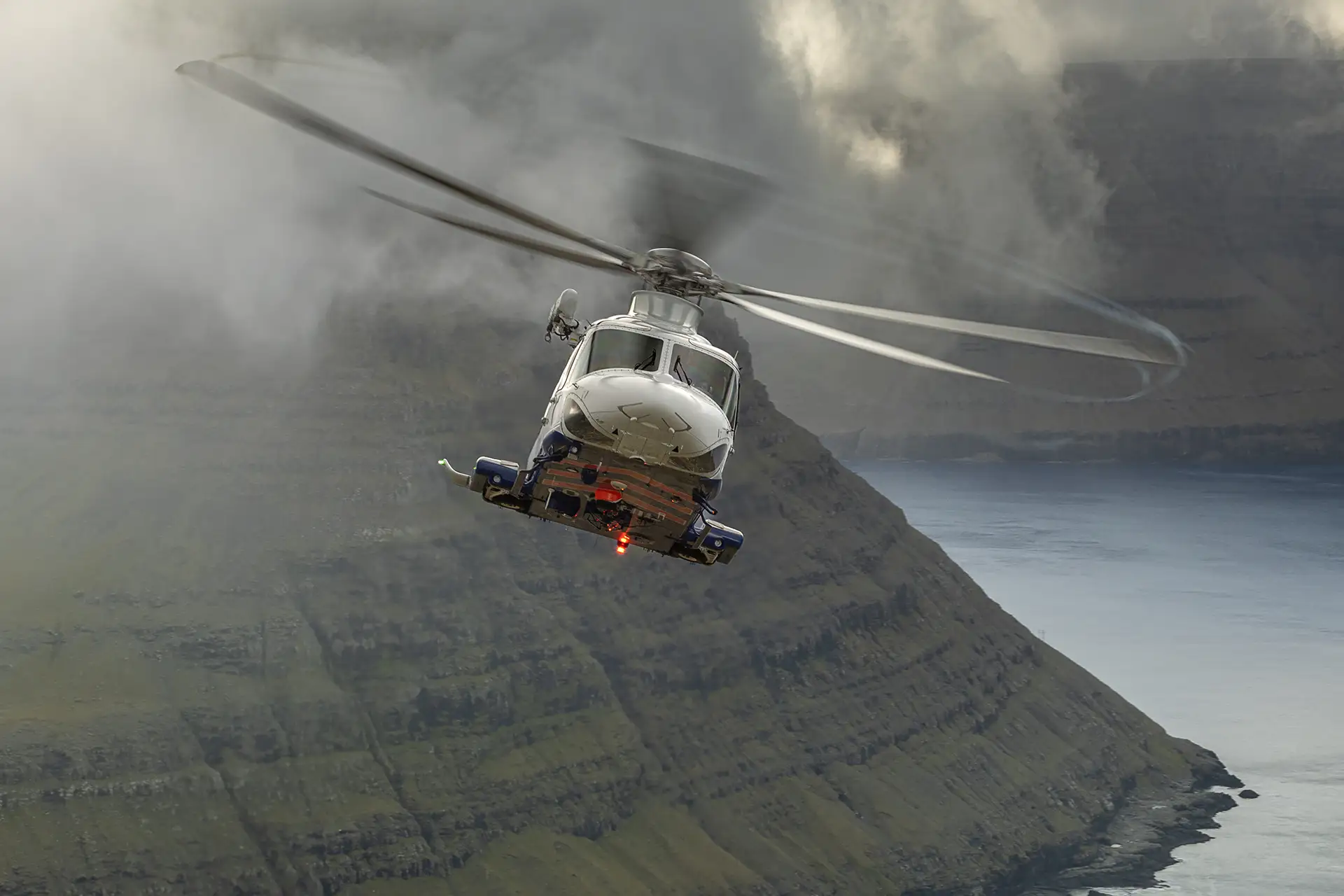
Scheduled Services
While not as prominent as SAR/HEMS, inter-island scheduled services have proven just as vital to Faroese Islanders and the 139 has proved adept at providing these transport services. With a capacity of 14 passengers and luggage, domestic helicopter services connect islands like Tórshavn, Klaksvík, and Mykines on specific days and are highly integrated into the islanders’ lives. About 500 flying hours are used each year to transport up to about 13,000 people on scheduled services that hop between the islands; although the distances aren’t huge, the number of landings and takeoffs is quite significant, “around 3000 landings per year in connection with scheduled passenger flights only,” commented Captain Jakobsen.
Bookings are made online with 10 destinations possible. The Faroese government subsidizes the scheduled flights for residents of the smaller islands to give them a regular connection to the mainland. Sector fares range from 255 DKK (US$37) to 1080 DKK (about US$170) for non-residents. The longest flight sector is about 15 to 20 minutes, depending on the weather. Each pad has a small terminal building for the ground crew and passengers to be protected from the weather and to view the safety briefing video. At each of the pads, the ground crew ensure the passengers receive the safety briefing before boarding, check that the passengers are strapped into their seats, and close or open the doors. They also load/unload baggage and conduct fuelling, when needed.
Although the helicopter is an all-weather aircraft, the pads are not designed for instrument conditions, so the service suffers weather aborts during scheduled operations. Based at, and operating from Vágar Airport, they rarely suffer weather aborts during HEMS/SAR operations. Those few aborts in HEMS/SAR are usually due to technical issues.
For many islanders, the only other means of transport between the islands is by boat, which is often an uncomfortable and potentially hazardous ride, even when available, given the weather that frequently lashes the Faroes. The island of Dímun is accessible only by helicopter, while during the winter, the helicopter is the only way to access Mykines.
Essential Service
As Atlantic Airways’ helicopter service continues to prove itself to be essential to the Faroese lives and the islands’ nascent tourist
industry, the company has also invested heavily in a modern aviation training center, which houses a variety of simulators. Although the
Faroe Islands represent a small community by national standards, its investment in and support for its helicopter service have proved
effective in saving lives and making life easier.

Thanks to the crew for providing so much of their time and knowledge.
In the cockpit
Capt. Hans Erik G. Jakobsen
Rani Herup
Rescue Swimmers/Hoist Operators
Bjørn Sjúrður Patursson
Bjarni Niclasen
Hans Jakup Venned
 HOME
HOME